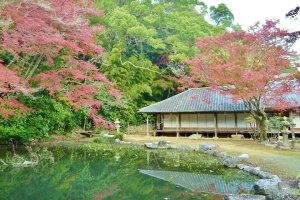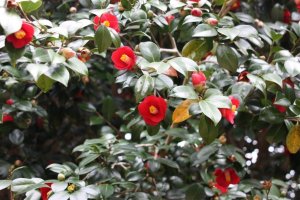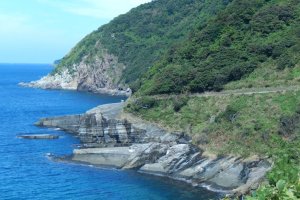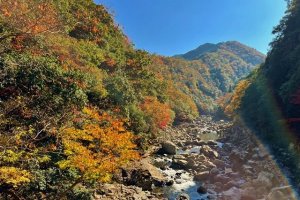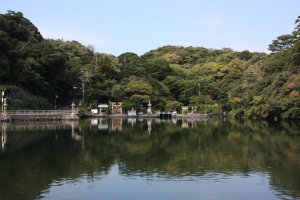Situated in southern Japan’s Yamaguchi Prefecture, Hagi City is a seaside area renowned for its natural beauty, cultural heritage, and nostalgic castle town.
With centuries of flourishing history, Hagi City is home to numerous UNESCO World Heritage Sites and is the birthplace of nationally-acclaimed Hagi Yaki, a type of Japanese pottery. Outside its urban developments, Hagi City is blessed with diverse natural landmarks—from striated oceanside cliffs to a lush camellia grove.
Although Hagi City has fewer tourists compared to other tourist hotspots, its assortment of wonders makes it a superb place to explore an equally fascinating and authentic side of Japan. Listed below in no particular order are 11 destinations and experiences you must visit/try in Hagi City. Pack your bags, and discover the area’s charm for yourself!
Nature
1. Mt. Kasayama Camellia Grove

The Mt. Kasayama Camellia Grove began in the 1970s when Hagi City cleared an overgrown plot of land of everything except the existing camellias since a well-known camellia expert determined that the land was optimal for the flowers’ growth. Fast-forward to today, and the 10-hectare grove is home to around 25,000 camellias that bloom from early December to late March—with their peak being mid-February to late March. Guests can enjoy multiple varieties, colors, and sizes of the vibrant flower along paths that weave through the area. During the peak season, the city holds the Hagi Camellia Festival and visitors from all over Japan flock to the area to see the fairytale-esque environment. The blooming camellias coupled with the petal- and flower-adorned trails make for enchanting visuals. Be sure to visit the park’s 13-meter observation deck for elevated panoramas of the massive grove.
2. Susa Hornfels

One of Hagi City’s most iconic natural monuments are the Susa Hornfels. These rocky cliffs have alternating striations of black shale and light gray sandstone, resulting in a unique striped appearance. These mesmerizing cliffs are located in northern Hagi and sit along the Sea of Japan. The seemingly manmade, yet purely natural facade of the cliffs juxtaposed against the blue skies and expansive ocean make for a one-of-a-kind vista you will not want to miss.
3. Chomonkyo

Chomonkyo, or Chomon Gorge, follows Hagi’s Abu River and is designated as both a National Site of Scenic Beauty and a Yamaguchi Prefectural Natural Park. The rocky riverbank is flanked by forest-clad hills and offers scenic views year-round. However, the most popular time to visit is in autumn when yellow, orange, and red foliage elevate the already captivating scenery. To explore this area, guests can follow a 5.1-kilometer path that starts about 300 meters from the Chomonkyo Gorge Roadside Rest Stop. This path lies adjacent to the Abu River and passes numerous points of interest—including Takashima Domon cave, Momijibashi bridge, and restaurants Suzugachaya and Ryugu-buchi, the latter of which sells sweetfish caught straight from the river. While you are in the area, be sure to check out Chomonkyo Gorge Roadside Rest Stop as well to enjoy some of the region’s local cuisine.
4. Myojin-ike Pond

Located at the base of Mt. Kasayama, Myojin-ike Pond is a tree-encircled, saltwater lake listed on the National Register of Natural Monuments. The lake is divided into three parts—Ōike (large pond), Nakanoike (middle pond), and Okunoike (inner pond)—and is linked to the sea, causing its water level to change according to the tide. In this unique environment, you can observe a variety of saltwater fish, as well as hawks and similar birds of prey. Sometimes, locals even have stands where you can purchase bread to feed the fish! Aside from the animal life, you can also visit Itsukushima Shrine at the lake’s western end and enjoy serene visuals of traditional torii (gates), stone lanterns, and shrine structures along the water. Thanks to its unique saltwater composition, scenic scenery, and abundance of animal life, Myojin-ike Pond is a great place to connect with nature.
Culture and History
5. Daishoin Temple

Daishoin Temple was founded in 1656 as a family temple for the Mori Clan, a group of lords who ruled Hagi City during the Edo Period (1603-1867). The temple belongs to the Rinzai school of Zen Buddhism and is the resting place for half of the Mori Clan lords. The Mori Clan followed a burial system in which odd- and even-numbered generations were buried separately. The graves of the first lord and even-number generations are at Daishoin Temple, and the remaining odd-numbered ones are at Tokoji Temple. Today, Daishoin Temple is home to multiple buildings that are designated as National Important Cultural Properties—including the main hall—where you can admire the simple elegance of Zen Buddhism architecture. However, the temple’s main lure is the Mori Clan graveyard. This cemetery is located in the forest behind the temple and is filled with over 600 stone lanterns donated by the clan’s loyal vassals. The sacred and traditional atmosphere interwoven in nature makes for an inspiring visit.
6. Tokoji Temple

Established in 1691 by the Mori Clan—a group of lords who ruled Hagi City during the Edo Period (1603-1867)—Tokoji Temple belongs to the Obaku School of Japanese Zen Buddhism and serves as the resting place for half of the clan. As detailed above under Daishoin Temple, the Mori Clan buried its first lord and even-number generations at Daishoin Temple and its remaining odd-numbered lords at Tokoji Temple. In contrast to Daishoin Temple’s Japanese style, Tokoji Temple’s appearance is heavily influenced by Chinese Buddhism. The outer gate, main gate, bell tower, and main hall all illustrate Chinese Zen architecture and are recognized as Important Cultural Properties. In the woods behind the temple, the Mori Clan graveyard features over 500 donated stone lanterns and multiple torii, creating a pensive environment imbued with tranquility and spirituality.
7. Unrinji (“Cat Temple”)

Calling all cat lovers! Unrinji, nicknamed Cat Temple or Neko-dera in Japanese, is an over 400-year old temple that was once a sub-temple of Tenjuin—also located in Hagi City. Unrinji gained its feline-loving reputation after a legend linked to Tenjuin’s enshrined feudal lord. The story goes that after the feudal lord’s death, his retainer committed ritualistic suicide, prompting his cat to bite through its tongue and eventually die from grief. Following the cat’s death, mournful meowing echoed throughout Tenjuin at night. Only once one of the monk’s performed a memorial service for the cat’s spirit, did the meowing cease. In 1996, Unrinji’s head monk revitalized the cat legend, forever entwining it with the temple’s legacy. Today, the complex is home to a variety of wooden cat statues, cat-inspired ema (votive tablets) and protective amulets, and cat-themed artwork—some of which were donated by anime and manga studios. For a traditional temple experience with a cat twist, Unrinji is a must visit.
8. Hagi Yaki

A list about Hagi City would be incomplete without mentioning Hagi Yaki. Hagi Yaki originated in 1604 and is one of Japan’s most celebrated types of pottery. This pottery is frequently used in tea ceremonies and is renowned for its soft porous texture, which allows tea to seep into the surface and subtly chain the color over time. This phenomenon is called the ‘seven disguises’ of Hagi Yaki and for many, increases the charm of the pottery. As the birthplace of Hagi Yaki, Hagi City is home to a number of Hagi Yaki museums, as well as pottery-related activities, such pottery-making and shopping. Given its national acclaim and importance in Japanese culture, Hagi Yaki makes for a phenomenal souvenir.
9. Yukawa Family Old Residence

The Yukawa Family Old Residence is a former collective residence for samurai and is located along the Aibagawa Waterway at the divergence of the Abu River. This historical structure is expertly preserved and whisks visitors to another era with its traditional wooden architecture. The building consists of numerous rooms, including a traditional tearoom, that beautifully illustrate past life through their designs and displayed artifacts. One of the home’s most fascinating features is its water distribution system in which water from the Aibagawa Waterway flows through the kitchen for domestic needs, as well as the onsite aquatic garden. The combination of historical architecture and natural charm make the Yukawa Family Old Residence a unique way to interact with the past.
Accommodations
10. HAGI HONJIN

Resting atop a hill overlooking Hagi’s nature-entwined cityscape, HAGI HONJIN is a Japanese-style hotel popular for its refined lodging experience and variety of natural hot spring baths. The hotel’s 14 different baths are located indoors and outdoors and feature calming views of the facility’s spacious gardens. The water is said to make bathers’ skin more beautiful and soothe neuralgic and joint pains. In terms of cuisine, the hotel serves elegant spreads of fresh seafood—including blowfish—as well as seasonal mountain cuisine, both of which perfectly complement the accommodation’s nourishing atmosphere. For its guest rooms, HAGI HONJIN has Japanese and Western-style bedrooms to ensure that all guests have a comfortable stay. Outside the facility, you can take a hotel-run shuttle bus to Mt. Azumayama’s summit and admire panoramic views of the area while enjoying a footbath!
11. Hagi Komachi

Hagi Komachi is a healing inn that rests directly on the Sea of Japan. The expansive accommodation boasts seven charms—oceanside views, facilities focused on entertainment and relaxation, luxurious guest rooms, hot spring baths, traditional Japanese cuisine, family-friendly amenities, and women-specific services. Given its breadth of offerings, Hagi Komachi is suitable for a variety of travelers’ needs. Here, you can relax in nourishing hot spring waters with views of the sea, challenge your friends to table tennis, book a massage, enjoy family time in the toy-filled kids room, and much more. All the while, the hotel serves expertly crafted cuisine that incorporates traditional Japanese techniques, the chef’s creative liberties, and elements of Western-style food. The dishes feature local seafood, seasonal ingredients, and delicious wagyu beef. At the end of the day, you can retire to a peacefully-designed Japanese, Western, or fusion-style guest room. After your stay, you are guaranteed to leave feeling refreshed and rejuvenated!
Access to Hagi City
The most common ways to access Hagi City are via plane, Shinkansen, and express bus. The two closest airports to Hagi City are Yamaguchi Ube Airport and Hagi Iwami Airport. Flights to these airports depart from Tokyo Haneda Airport on a daily basis and take about 95 minutes. From the airports, Hagi City is 70 to 80 minutes away via a direct taxi service (reservations required) or rental car. There are also numerous bus options available.
For the Shinkansen, JR Shin-Yamaguchi Station is the closest Shinkansen station to Hagi City. Shin-Yamaguchi Station is on the main Sanyo Shinkansen line and is four hours and 30 minutes from Tokyo, two hours from Osaka, 32 minutes from Hiroshima, and 35 minutes from Fukuoka. Once you reach JR Shin-Yamaguchi Station, you can take a bus to Hagi City, which takes between 70 and 90 minutes.
Lastly, you can reach Hagi City via an express bus from Tokyo Station, Kyoto Station, Shin-Osaka Station, and Sannomiya Bus Terminal in Kobe. These journeys take about 14 hours and 30 minutes, 13 hours and 15 minutes, 12 hours and 20 minutes, and 10 hours and 45 minutes respectively.


